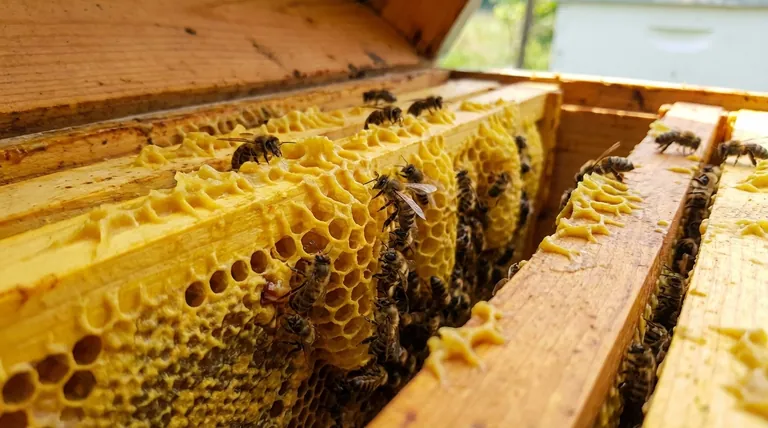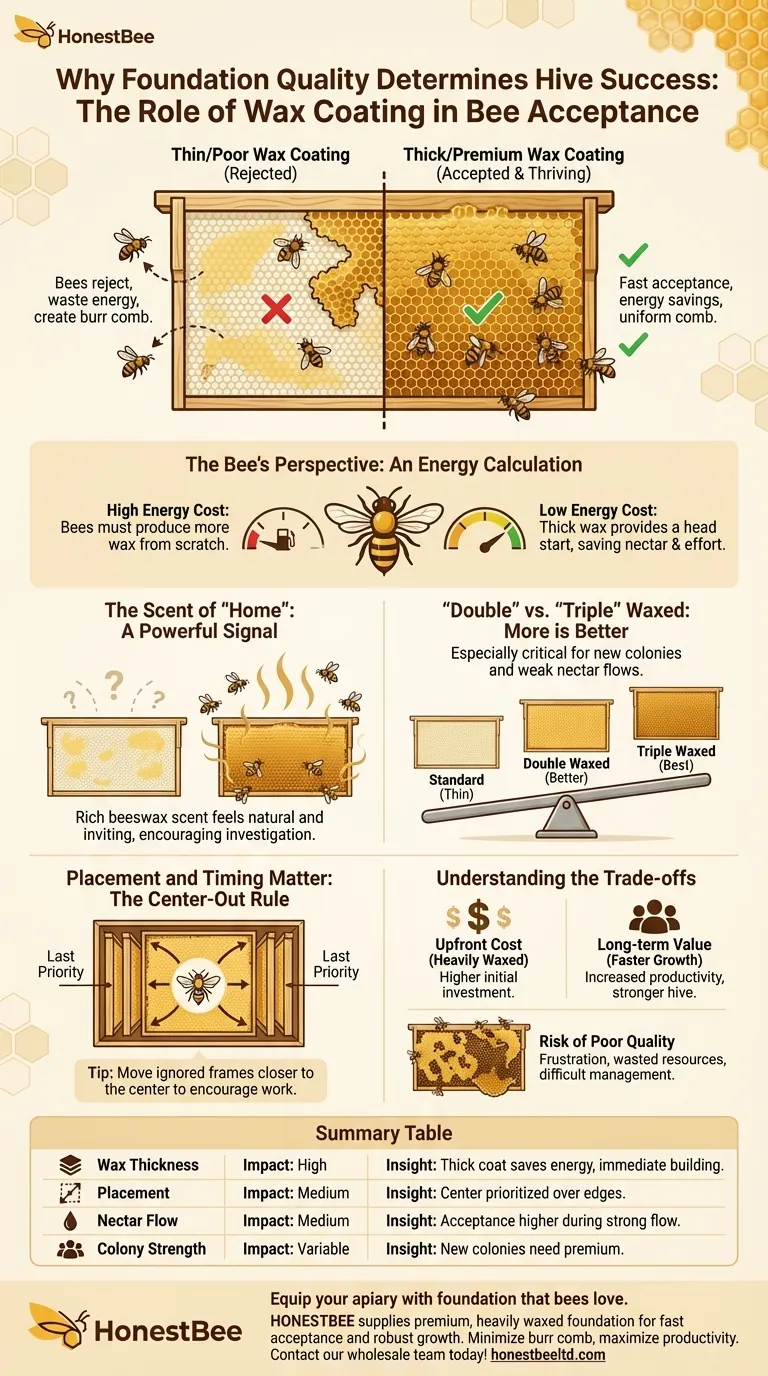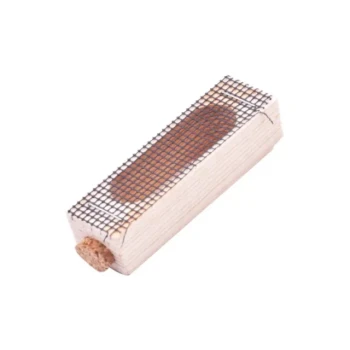The quality of your foundation is one of the most significant factors in its acceptance by a honey bee colony. The role it plays is critical, as bees are instinctively drawn to foundation that offers them the most efficient start for comb building. For plastic foundation, this means a thick, high-quality wax coating is paramount for ensuring fast and uniform acceptance.
Bees operate on a principle of resource efficiency. They will readily accept and build upon foundation that has a heavy wax coating because it saves them the significant energy required to produce their own wax from scratch.

Why a Thick Wax Coat is the Deciding Factor
The choice to build on a frame is not arbitrary; it's a calculation of cost versus benefit from the colony's perspective. A high-quality foundation tips this calculation in your favor.
The Bee's Perspective: An Energy Calculation
Producing beeswax is one of the most energy-intensive tasks for a honey bee, requiring them to consume large amounts of nectar or honey.
A foundation with a thick wax coating provides a substantial head start. The bees perceive this as a low-energy-cost opportunity, making them far more likely to begin drawing comb on it immediately.
The Scent of "Home"
Beeswax has a distinct and attractive scent to honey bees. A foundation that is heavily coated with pure beeswax smells more natural and inviting to the colony.
This scent acts as a powerful signal, encouraging them to investigate and begin working the frame, whereas a bare or thinly coated piece of plastic can feel foreign and unappealing.
"Double" vs. "Triple" Waxed Foundation
Many suppliers offer foundation with varying levels of wax, often marketed as "double" or "triple" waxed. While these terms are not standardized, the principle is sound.
More wax is almost always better. This is especially true when establishing a new, small colony or during periods of weak nectar flow when bees are more reluctant to expend energy on comb construction.
Beyond Quality: Placement and Timing Matter
Even the best foundation can be ignored if not presented correctly. Bee behavior and environmental conditions are just as important as the material itself.
The "Center-Out" Rule of Construction
A honey bee colony organizes its hive with a distinct logic. The queen lays eggs in the center, and the bees work from this central brood nest outwards.
Frames placed on the absolute edges of the hive box are often the last to be touched. The bees will prioritize drawing out comb in the warm, active center of the hive before expanding to the periphery.
A Practical Fix for Ignored Frames
If you find your bees are ignoring foundation, especially on the outer edges, you can use their natural tendency to your advantage.
Carefully move one of the undrawn frames one or two positions closer to the center of the box. This places the frame in their primary workspace, dramatically increasing the odds they will begin to draw it out.
Understanding the Trade-offs
Choosing the right foundation involves balancing cost, speed, and risk. Understanding these factors will help you make a more informed decision.
The Upfront Cost
Heavily waxed foundation is more expensive. This added cost can be a significant factor, especially when setting up multiple new hives.
However, this initial investment often pays for itself in colony productivity. Faster comb production means the queen has more space to lay eggs and workers have more space to store honey, leading to a stronger, more productive hive sooner.
The Risk of Poor-Quality Foundation
Using foundation with a thin or poor-quality wax coating is a common cause of frustration. Bees may refuse to draw it out at all.
Worse, they may build rogue "burr comb" in the empty spaces between frames instead of using your foundation, creating a mess that is difficult to manage and inspect. This wastes the colony's time and energy during critical periods.
Making the Right Choice for Your Hive
Your goal for the colony should guide your foundation strategy.
- If your primary focus is establishing a new colony quickly: Invest in premium, heavily waxed foundation to give the bees the fastest and most attractive start possible.
- If your primary focus is expanding a strong, established hive: You can use standard foundation, but ensure you place it near the active brood nest during a strong nectar flow to guarantee acceptance.
- If your primary focus is troubleshooting ignored frames: First, confirm there is an active nectar flow, then move the ignored frame closer to the center of the hive to encourage the bees to work it.
By aligning your foundation choice with the bees' natural instincts for efficiency, you empower your colony to build, grow, and thrive.
Summary Table:
| Factor | Impact on Bee Acceptance | Key Insight |
|---|---|---|
| Wax Coating Thickness | High | A thick coat saves bees energy, encouraging immediate comb building. |
| Foundation Placement | Medium | Frames near the hive center are prioritized over outer edges. |
| Nectar Flow Period | Medium | Bees accept foundation more readily during strong nectar flows. |
| Colony Strength | Variable | Strong colonies may accept standard foundation; new colonies need premium. |
Equip your apiary with foundation that bees love. HONESTBEE supplies commercial apiaries and beekeeping equipment distributors with premium, heavily waxed foundation designed for fast acceptance and robust colony growth. Let us help you minimize burr comb and maximize productivity—contact our wholesale team today to discuss your needs and bulk pricing!
Visual Guide

Related Products
- Beeswax Foundation Sheets Beehive Foundation for Wholesale
- Notebook Style Beeswax Foundation Mould Wax Foundation Mold
- Food Grade Plastic bee Foundation for Bee Frames
- Manual Beeswax Comb Foundation Machine Wax Foundation Mill Embossing Machine
- Colorful Silicone Beeswax Foundation Mold Mould for Beekeeping
People Also Ask
- What are wax sheets made of? A Guide to Pure Beeswax Foundation for Healthy Hives
- How do beeswax foundations save bees time and energy? Boost Hive Productivity & Honey Yield
- What are the characteristics of beeswax foundation? A Natural Choice for Healthy Hives
- What is beeswax foundation used for? A Guide to Efficient Hive Management
- How do you store beeswax foundation? Prevent Wax Moth Damage and Preserve Quality



















